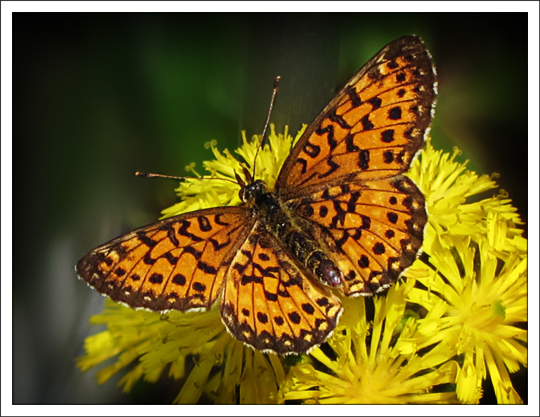Butterflies of the Adirondack Mountains:
Silver-bordered Fritillary (Boloria selene)
 Butterflies of the Adirondacks: Silver-bordered Fritillary (Boloria selene) in the Paul Smiths VIC Butterfly House (19 June 2012)
Butterflies of the Adirondacks: Silver-bordered Fritillary (Boloria selene) in the Paul Smiths VIC Butterfly House (19 June 2012)
| This page is no longer being updated. For an updated version of this material, see: Silver-bordered Fritillary (Boloria selene). |
The Silver-bordered Fritillary (Boloria selene) is an orange and black butterfly that may be seen in the Adirondack Mountains of upstate New York in summer. It is a member of the Brushfoot family. [1] This butterfly is one of the lesser fritillaries. [2] [3] It is noticeably smaller than the other fritillaries seen at the Paul Smiths VIC Native Species Butterfly House. [4] Some sources refer to it as the Silver Meadow Fritillary,[5] while others refer to it as the Small Pearl-bordered Fritillary. [6] This butterfly reportedly is named after Selene, a lunar deity in Greek mythology. [7]
From above, the Silver-Bordered Fritillary is orange with black markings. The black margins enclose pale orange spots. [8] [9] From below, this butterfly has a silver border along both outer wing margins. [10] It also has four rows of metallic silver spots. [11] The wing span of the Silver-bordered Fritillary is about 1.6 inches. [12]
Male Silver-bordered Fritillaries patrol wet areas for females, [13] who lay their eggs singly near host plants. [14] Caterpillars feed on the leaves of violets. [15] [16] [17] Adult butterflies consume nectar from flowers such as goldenrod and black-eyed susans. [18]
The range of the Silver-bordered Fritillary extends from Alaska east to Newfoundland and south to Oregon, New Mexico, Illinois, and North Carolina. [19] Silver-bordered Fritillaries prefer wet areas, such as meadows and bog margins, often near wooded areas.[20] [21] It nectars in adjacent fields. [22]
In 2012, the Silver-bordered Fritillary was present in the Paul Smiths VIC Native Species Butterfly House in June.[23]
References
- Susan Grimm Hanley. Interpretive Naturalist, Paul Smith's College Native Species Butterfly House. Species Logbooks.
- Butterflies and Moths of North American. Species Profiles. Sighting records: 6/16/12
- Government of Canada. Canadian Biodiversity Information Facility. SpeciesBank.
- Massachusetts Butterfly Club. Massachusetts Butterfly Species List.
- ENature. Field Guides.
- Iowa State University. Department of Entomology. BugGuide.
- Ross A. Layberry, Peter W. Hall, and J. Donald Lafontaine. The Butterflies of Canada (University of Toronto Press, 1998), pp. 176-177, Plate 14.
- National Audubon Society. Field Guide to Butterflies (New York: Alfred A. Knopf, 1981), pp. 550-560.
- Jim P. Brock and Kenn Kaufman. Kaufman Field Guide to Butterflies of North America (Houghton Mifflin, 2003), pp. 170-171.
- Paul A. Opler. A Field Guide to Eastern Butterflies (The Peterson Field Guide Series, Houghton Mifflin Company, 1992,1998), pp. 78-79, 243.
- Jeffrey Glassberg. Butterflies of North America (Michael Friedman Publishing, 2002), pp. 130-131.
- James A. Scott. The Butterflies of North America. A Natural History and Field Guide (Stanford University Press, 1986), pp. 318-319.
- Jeffrey Glassberg. Butterflies through Binoculars. The East. A Field Guide to the Butterflies of Eastern North America (Oxford University Press, 1999), p. 107-108, Plate 29.
- Paul A. Opler and George O. Krizek. Butterflies East of the Great Plains: An Illustrated Natural History (The Johns Hopkins University Press, 1984), pp. 137, Plate 23.
- Rick Cech and Guy Tudor. Butterflies of the East Coast. An Observer's Guide (Princeton University Press, 2005), p. 167.
- David Carter. Butterflies and Moths (Dorling Kindersley, Inc., 1992), p. 134.
- Thomas J. Allen, Jim P. Brock, and Jeffrey Glassberg. Caterpillars in the Field and Garden. A Field Guide to the Butterfly Caterpillars of North America (Oxford University Press, 2005), pp. 82-83.
